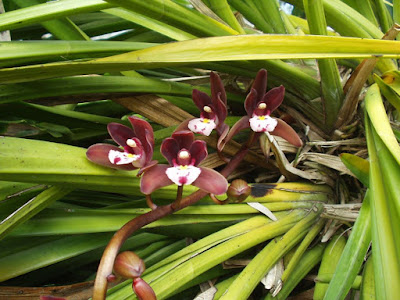The Black Purple Cymbidium is native to the southern Thailand, Central Malaysia, Vietnam, Borneo, Sumatra and the Philippines. In Malaysia, this plants was found near Malacca and in the states of Johore and Pahang. In Sumatra, the plants were harvested near Palembang. At Borneo, they were found in Kalimantan and Sabah. It can usually be found in the deformities of thick branches of forest trees, occasionally on rocks. It grows, as a rule, in lowland areas and in the lower layers of mountain forests at an altitude of 1200 m, but it also occurs in the mountains at an altitude of up to 2,200 m.
Cymbidium atropurpureum orchid, also called as The Black Purple Cymbidium, is a species of the genus Cymbidium. Several synonyms are know for this species such as: "Cymbidium atropurpureum var olivaceum J.J.Sm. 1910"; "Cymbidium finlaysonianum var atropurpureum [Lindl.] Veitch 1894"; "Cymbidium pendulum var. atropurpureum Lindl. 1854"; "Cymbidium pendulum var. purpureum [Roxb.] W. Wats. 1890". This species was first described by (Lindl.) Rolfe in 1903.
IDENTIFY CYMBIDIUM ATROPURPUREUM ORCHID
The Black Purple Cymbidium is native to the southern Thailand, Central Malaysia, Vietnam, Borneo, Sumatra and the Philippines. In Malaysia, this plants was found near Malacca and in the states of Johore and Pahang. In Sumatra, the plants were harvested near Palembang. At Borneo, they were found in Kalimantan and Sabah. It can usually be found in the deformities of thick branches of forest trees, occasionally on rocks. It grows, as a rule, in lowland areas and in the lower layers of mountain forests at an altitude of 1200 m, but it also occurs in the mountains at an altitude of up to 2,200 m.
It is a large sized, hot to cool growing terrestrial or lithophyte which can reach the height of 60-100 cm with clustered pseudobulbs. The pseudobulbs is up to 10 cm high. They are ovate, often slightly inflated, flattened on both sides, at the base they are surrounded by leaves and four thin, dry, leaflike scales. On each pseudobulb grows from 7 to 9 fairly hard, arcuate, curved, leathery leaves 50-90 cm long and about 1.5-4.0 cm wide.
Cymbidium atropurpureum orchid blooms in the summer and fall on an arched or strongly hanging flower-spike 28-75 cm long appears at the base of the pseudobulb from the cover formed by stipules. There are 10 - 33 blossoms are carried on each inflorescence. Their aroma resembles the smell of coconut. Petals are dark maroon, sepals can be from dark maroon to dark yellow-green with dark maroon stains. The lip is white with burgundy-purple spots on the side parts and with a yellow crest in the center of the middle part. The column is dark maroon, the anther cover is white or light yellow. In the Philippines and Borneo, plants are also found in which all the petals and sepals have the color of a dark red wine. Flowering is stimulated by daily changes of 7-9 ° C between day-time and night-time temperatures.
GROW AND CARE CYMBIDIUM ATROPURPUREUM ORCHID
It is one of the Cymbidium of easy cultivation and presents no difficulty.
Light:
Cymbidium atropurpureum orchid is quite in need of light intensity. It requires 25000-35000 lux; the light must be filtered or diffused; the direct morning sun is fine, it must be protected from direct sunlight from 12h to 16h in the afternoon. A constant ventilation is necessary.
Temperature:
One of the factors that make this species easy to grow compared to many other Cymbidiums are its preferred temperatures: 26-29 ° C during the day and 18-19 ° C at night throughout the year. The overhang between day and night must be 7-9 ° C. This can be achieved by placing the plant outdoors during the summer months.
Humidity:
In its natural habitat, air humidity always remains above 60%, and we must maintain it at these levels even in cultivation.
Cultivate, growing medium:
Due to its nature and its size, Cymbidium atropurpureum is grown exclusively in pots. The vase you choose must be just a little bit larger than the cluster of its roots. As a substrate, a mix based on either fir bark or chopped tree-fern fiber is used by most growers. Chopped sphagnum moss, osmunda, gritty sand, perlite, charcoal, and fibrous loam are frequently added in varying amounts to the basic media. This species needs abundant and frequent watering, so our substrate must be well draining.
Watering:
Cultivated plants should be watered heavily while actively growing, but the medium should not be allowed to become stale or soggy. We take into account the fact that in winter the substratum puts more to dry, so the wetting will be less frequent than in summer.
Fertilizer:
A balanced fertilizer mixed at 1/2 - 3/4 recommended strength should be applied weekly from late spring through autumn when the plant is actively growing. Before fertilizing the plant, it is necessary to wet it, because in this way there is no risk that the fertilizer will burn the sensitive tips of the young roots.
To prevent a buildup of salt deposits, pots should be leached or flushed every few weeks when fertilizing heavily. This is especially true in areas with highly mineralized water supplies. To flush a pot, the plant should first be watered normally and then allowed to stand for about an hour to allow the accumulated salts in the medium to dissolve. The pot should then flushed with water equal to twice the volume of the pot to wash out the dissolved salts.
Repot:
The repottings must be done quite frequently, every 1-2 years, because the plant grows quickly and begins to overflow from the edge of the pot. Repotting should be done when new root growth starts in late winter if plants are not carrying an inflorescence. Otherwise, repotting should be done as soon after flowering as possible, with extra care to avoid breaking the brittle new roots.















COMMENTS